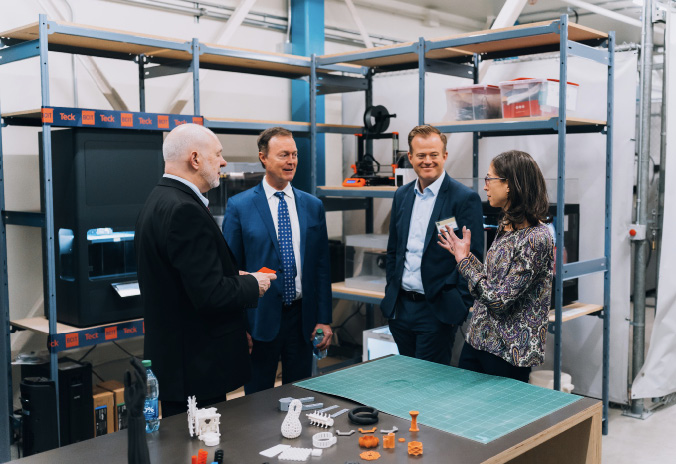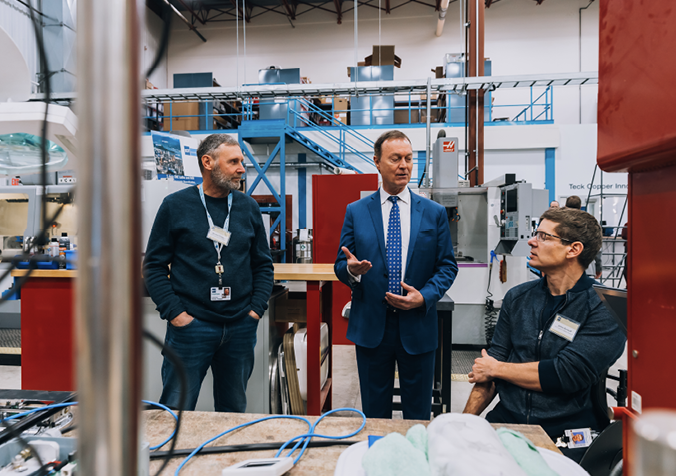The British Columbia Institute of Technology (BCIT) and miner Teck Resources have partnered once again for mining research, this time for a new facility at the university: the Teck Copper Innovation Hub.
By Donna Schmidt

Post-use of minerals, especially those that can help make life easier, safer and healthier, never fade into the background – society is always looking for more ways to put them to work. Innovation is always around the corner.
North American Mining recently sat down with Jay Schlosar, director of Copper & Health, Teck Resources, about one of those developments, the aptly named Teck Copper Innovation Hub, which is now open on the British Columbia Institute of Technology (BCIT). The facility was made possible by a C$1.75 million donation from the miner, but its returns will come in spades with the hub designed to facilitate innovation, research, training and education in additive manufacturing using copper.
“The Teck Copper Innovation Hub will conduct research and development on the design, capabilities and durability of healthcare devices composed of copper and plastic,” Schlosar said. “Copper has proven antimicrobial properties, which has been demonstrated to eliminate up to 99.9% of harmful bacteria on surfaces within two hours of contact. When installed on high-touch surfaces – including healthcare devices – copper is a proven killer of bacteria, reducing the spread of infection and improving health outcomes.”
The facility, which opened its doors January 31 at the BCIT Centre for Applied Research and Innovation, will also advance research projects and education focused on exploring new ways copper can be used to enhance health and safety in real-life applications. Additive manufacturing (3D printing), Schlosar said as an example, is compelling because it offers the ability to quickly create objects that serve as prototypes for real-world use in industry.
One of those important end uses: healthcare, specifically the use of antimicrobial copper in the sector. The statistics for just this industry are sobering; in Canada annually, more than 220,000 patients will contract a healthcare-acquired infection while receiving care. The total impact in terms of cost is estimated at C$4 billion. Also, each year, between 8,000 and 12,000 patients in Canada will die from healthcare-acquired infections.

Origin of the Hub and its partners
Schlosar noted the innovation hub is just one of many outcomes of a longstanding and impactful partnership between BCIT and Teck that has spanned more than 35 years. “The idea for the hub represents the natural intersection of BCIT and Teck’s respective commitments to innovation within their industries, and across communities they operate in,” he said.
“For Teck, the innovation hub will help to further research and development of additive manufacturing using copper. As a major copper producer, Teck is committed, through the Copper and Health program, to raising awareness and advocating for the use of copper as a solution to healthcare-acquired infections, as well as infections resulting from bacteria spread in busy public spaces.”
The campus itself was installed with antimicrobial patches in September 2021, and additional patches were installed at six additional locations, including the school’s new Health Sciences Centre.
With Teck’s involvement in the partnership, one natural question is how much of the operator’s copper is used. Turns out, not much, said Schlosar, as most of what it needed is sourced on the open market.
“The goal of the program is to improve health and safety for communities. The value is supporting healthcare professionals and researchers to help make communities safer by expanding the use of antimicrobial copper through our Copper and Health program,” he said.
Capabilities and the future
As noted, the main technology at play within the walls of the innovation hub is additive manufacturing, which will create healthcare devices composed of copper and plastic. However, ongoing research and development at the facility will also look at the design capabilities and durability of antimicrobial copper when used in conjunction with these devices.
Currently, researchers and students are analyzing the production and use of prosthetics and orthotics made of plastic and copper, using 3D tech, which Schlosar said indicates “tremendous potential” for widespread use and impact.
That in itself could be life-changing for many, but Teck and BCIT are happy to also report the hub will have an overall economic impact as well, to the tune of up to $12 million in the coming half-decade in research and development, new business, employment, and exports.
“In addition to healthcare, Teck’s Copper and Health program, which was initiated in 2017, has supported advancements in the use of antimicrobial copper in public spaces, including across transportation, education, healthcare and in commercial and business spaces,” he said.
“The widespread reach of the program is indicative of the potential impact of further advancements in innovation in the use of copper. The Teck Copper Innovation Hub and Teck’s Copper and Health Program serve as pioneering examples of the important connections between mining critical minerals and public health and safety.”
The Teck Copper Innovation Hub will conduct research and development on the design, capabilities and durability of healthcare devices composed of copper and plastic.
The facility opened its doors January 31 at the BCIT Centre for Applied Research and Innovation.
